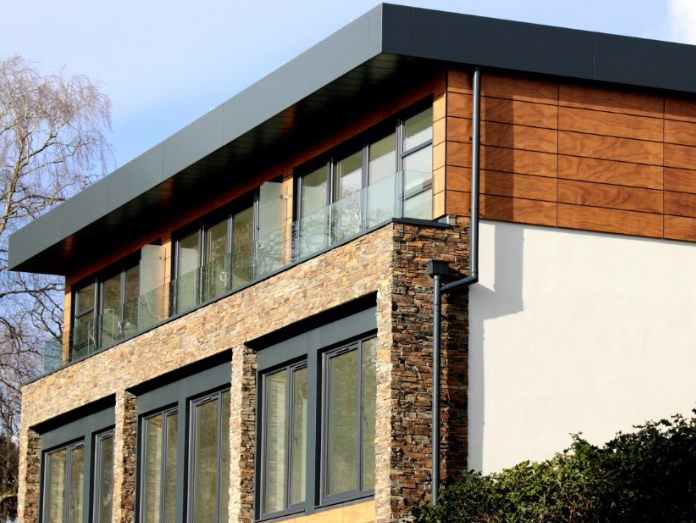If you’ve ever wished your windows could tint themselves on command—without blinds, curtains, or pulling down shades—you’re not alone. Electronically controlled window tint is a new kind of smart window technology that gives homeowners the ability to adjust their window tint with the push of a button.
This innovative system, often called smart glass or switchable film, uses special materials that respond to electricity. When voltage is applied, the window changes from clear to tinted, reducing heat, glare, and UV rays—while still allowing in natural light. It’s like having built-in, high-tech window treatments that you can control with a switch, a remote, or even automatically with sensors.
How Does It Work?
Electronically controlled window tint works by using electrochromic material or liquid crystals sandwiched between thin pieces of glass or applied as a smart film layer. When an electric current passes through the material, it rearranges the molecules, causing the glass to darken or lighten.
This type of smart window can be turned on or off manually, or set to react to sunlight, temperature, or time of day. Some products, like switchable smart glass, work instantly, while others tint gradually over a few minutes. Either way, the transition is smooth and lets you maintain your view without sacrificing comfort or privacy.
Types of Electronically Controlled Window Tint
There are a few different types of electronically controlled window tint available for homeowners. One common option is electrochromic glass, which changes tint when electricity is applied. Another is switchable film, a retrofit-friendly solution that can be added to your existing glass instead of replacing the whole window.
Smart film is often a thinner, flexible product that behaves similarly to smart glass, but is applied more like a traditional window film. It can be ideal for those looking for a cost-effective entry point into the world of electric window tinting.
Why Homeowners Are Interested in Smart Windows
The appeal of electronically controlled window tint goes beyond convenience. These systems can make your home more energy efficient by reducing the need for air conditioning during hot summer days. Some smart glass solutions also help insulate your home in the winter, keeping heat from escaping.
Homeowners also love the sleek look—no bulky window treatment needed—and the ability to control natural light without sacrificing their view. Whether you’re designing a modern home or upgrading an older space, switchable glass adds both function and wow factor.
Cost and Considerations
As with any newer technology, price can be a factor. The cost of electronically controlled window tint varies based on the type of glass, installation method, and total square foot of coverage. Switchable smart glass that replaces existing panes tends to be more expensive than smart film that applies to current windows.
While it may not be in every homeowner’s budget today, costs are coming down as the technology becomes more common.
Many people choose to start with just one room—like a sunny office or front-facing living room—and expand over time.
Is It Right for Your Home?
Smart windows aren’t just for luxury homes or office buildings anymore. More and more homeowners are exploring these systems for comfort, energy savings, and privacy. If your house gets too hot in the summer or you’re tired of constantly adjusting blinds and shades, electronically controlled window tint could be worth considering.
While not every window tinting company offers smart film just yet, it’s a fast-growing market. Some businesses—including local Oregon providers—can help you explore your options and determine the right solution for your home.
How It Compares to Traditional Window Tint
Traditional window tint is a passive solution. Once applied, it blocks sunlight and heat at a fixed level—it’s always on. In contrast, electronically controlled window tint is dynamic. You can change the level of tint whenever you want, or even automate it based on your schedule or sunlight levels.
While traditional tinting is typically more affordable and still highly effective, smart glass offers more flexibility and control.
It all comes down to your needs, budget, and how much tech you want in your home.
Frequently Asked Questions About Electronically Controlled Window Tint
Is electronically controlled window tint safe for my home?
Yes. It’s made with durable materials and installed by professionals to work safely with your windows and electrical systems.
Can I install it on just one room or window?
Absolutely. Many homeowners start with one space—like a home office or bedroom—before deciding to expand.
Does it still work when the power is off?
In most cases, the glass will remain in its current state (either tinted or clear) when not powered. Some systems default to tinted when off.
How long does smart window tint last?
With proper care and quality materials, smart film or glass can last 10 years or more.
Is it easy to control?
Yes! Most systems come with a switch, remote, or smart home integration for automatic control.
Curious About Smart Window Solutions? Let’s Talk.
Whether you’re designing a modern home or just exploring ways to improve comfort and energy efficiency, smart windows are an exciting option. Pacific Window Tinting has proudly served Oregon homeowners since 1998 with expert installation, honest pricing, and a commitment to customer satisfaction.
While we may not offer electronically controlled window tint yet, we’re always happy to answer your questions and help you explore the best tinting solutions for your home. Reach out today for a friendly, no-pressure consultation.
